
Neolithic
Relatively little is known about the Stone age in Naxos and in Greece, especially compared to the later times. But also in comparison to Central Europe our information about the human presence in Greece during the Stone age is quite poor. Only a few sites are known in Greece with finds from the Paleolithic and Mesolithic (600,000 to 8,000 B.C. and 8,000 to 6,500 B.C. respectively). Obsidian, which originates from the Cycladic island Milos, has been found on the Greek mainland in excavations that are dated at about 7,000 BC – which is one of the earliest evidences for seafare. No finds from the Paleolithic and Mesolithic had been discovered until recently in the Cyclades and Crete; however, new investigations show that the islands were inhabited much earlier than previously assumed.
Neolithic settlements on the Cyclades
We are better informed about the Neolithic age (6,500 – 3,200 B.C.) in Greece, especially the Late Neolithic (from 5,300 B.C.): Numerous finds date from this period, including quite a few from the Cyclades. Of great importance are the excavations on the small island of Saliagos between Paros and Antiparos, which was inhabited in the Neolithic age around 4,800 BC by fishermen who hunted tunafish that were here passing by close to the coast. In the excavations large quantities of obsidian spearheads with barbs and tuna remains were found. The culture of Saliagos shows no similarities with neighbouring simultaneous or later cultures and must be considered independent.
In Kephala on Kea a Stone age settlement with a neighbouring cemetery from about 3,600 BC was excavated. It revealed rich finds of pottery and obsidian, but also traces of metalwork. Kephala shows many similarities with simultaneous settlements on Euboea, in Attica and the Peloponnese, but also with the subsequent Cycladic culture of the Early Bronze age (e.g. small stone idols). The excavations in Saliagos and Kephala provided much information about the life of the Neolithic settlers in the Cyclades.
Stone age tools: Obsidian
The most characteristic material of the Stone age and one of the first materials humans used is obsidian (or the very similar flint). The Stone age people used obsidian to manufacture many of their first tools. It has a glass-like structure and forms flakes with sharp edges when it breaks, so it can be used to make scrapers, blades and arrowheads.
Obsidian is found in the Aegean area especially on the volcanic island of Milos, the most southwestern of the Cycladic Islands. It is of volcanic origin and can be found in ducts or layers. It consists mainly of silicates, solidified in a glass-like state, i.e. without the formation of crystals, so that it breaks with a typical conchoidal fracture. Obsidian is grey-black, sometimes with a slight green shimmer. On Milos obsidian was already mined around 7,000 BC. During the Stone age and the Bronze age it was an indispensable material and important resource, and was exported from Milos to all parts of the Aegean Sea and the adjacent mainland. Obsidian can be found literally in all Stone and Bronze age settlements.

Small obsidian splinters can be found in many places on Naxos. Obsidian is a black volcanic glass. The obsidian found on Naxos comes from the volcanic island of Milos and was imported to Naxos in the Neolithic and Bronze ages.

In many pieces it is visible that they were processed artificially.

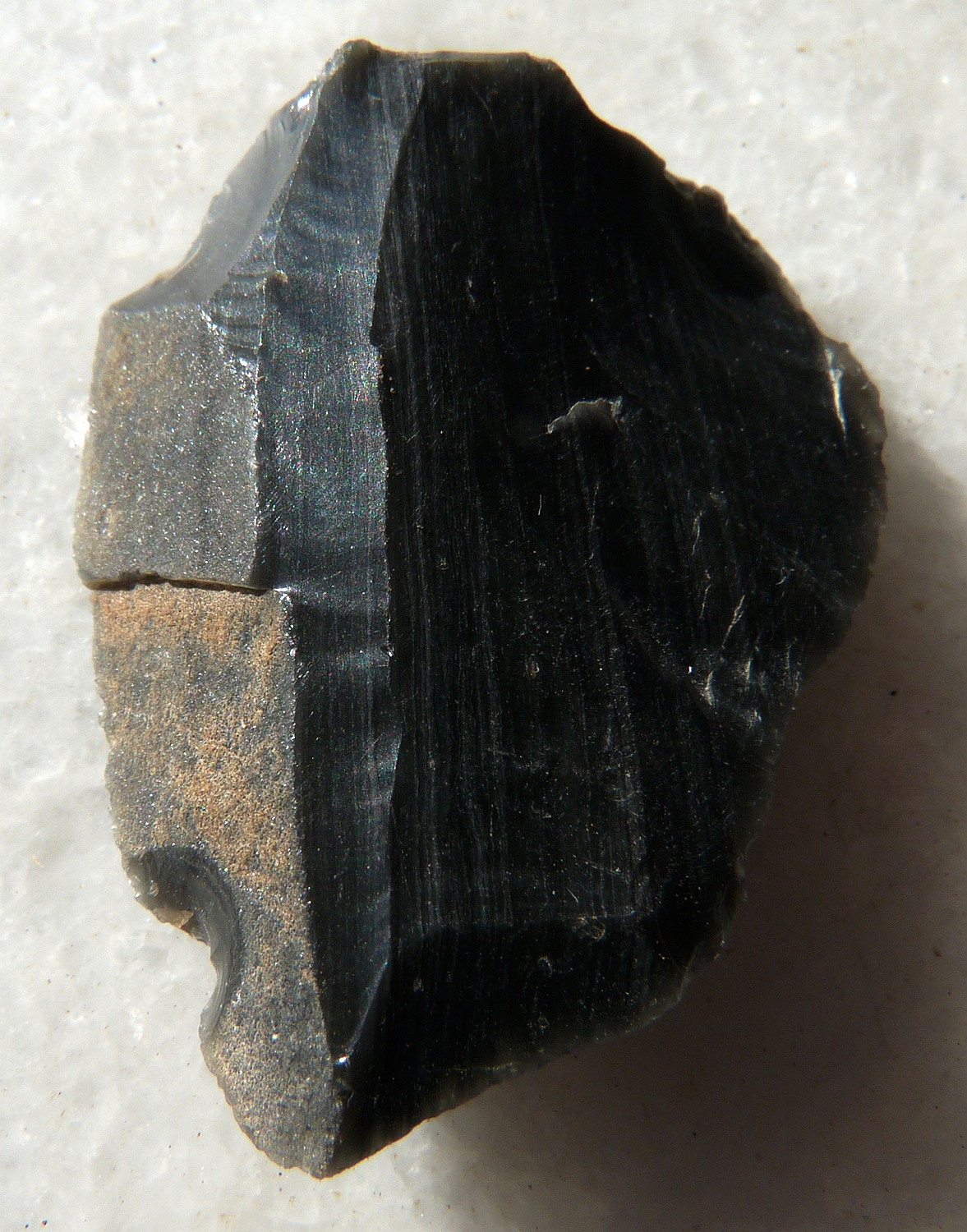
This flake shows characteristics of a man made tool (scraper). The piece was split off from a so-called core by a blow on the side facing upwards. Characteristic features of an man made tool can be seen, such as the bulging ventral side (left) with concentric ripples (Wallner lines: the “frozen” shock waves of the blow), the conical impact area (top middle) with characteristic very fine lines next to it. On the dorsal side (right) one sees the vertical ridges representing the edges of previous flakes split off from the same core.
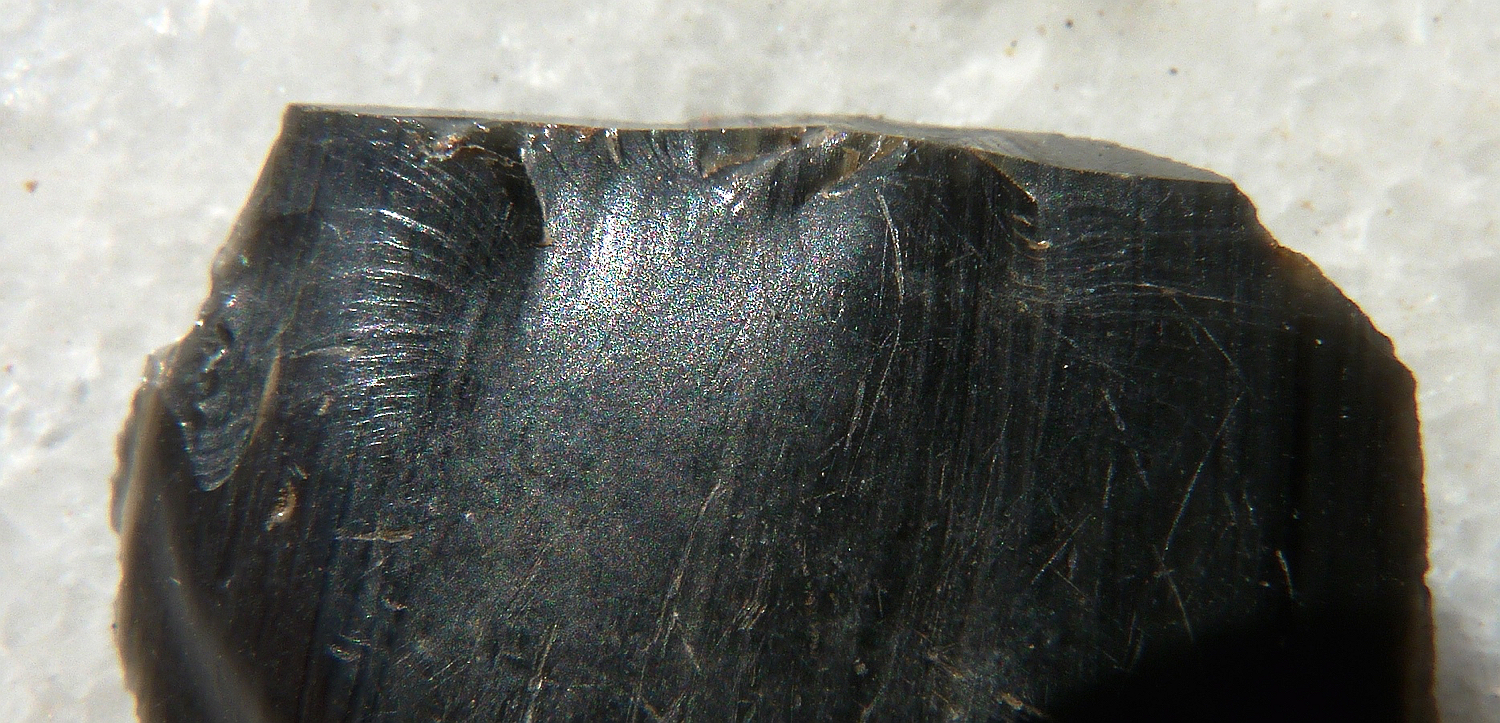
Here again the upper ventral side with the smooth striking platform and the point of impact with the conical bulge and the fine lines next to it.
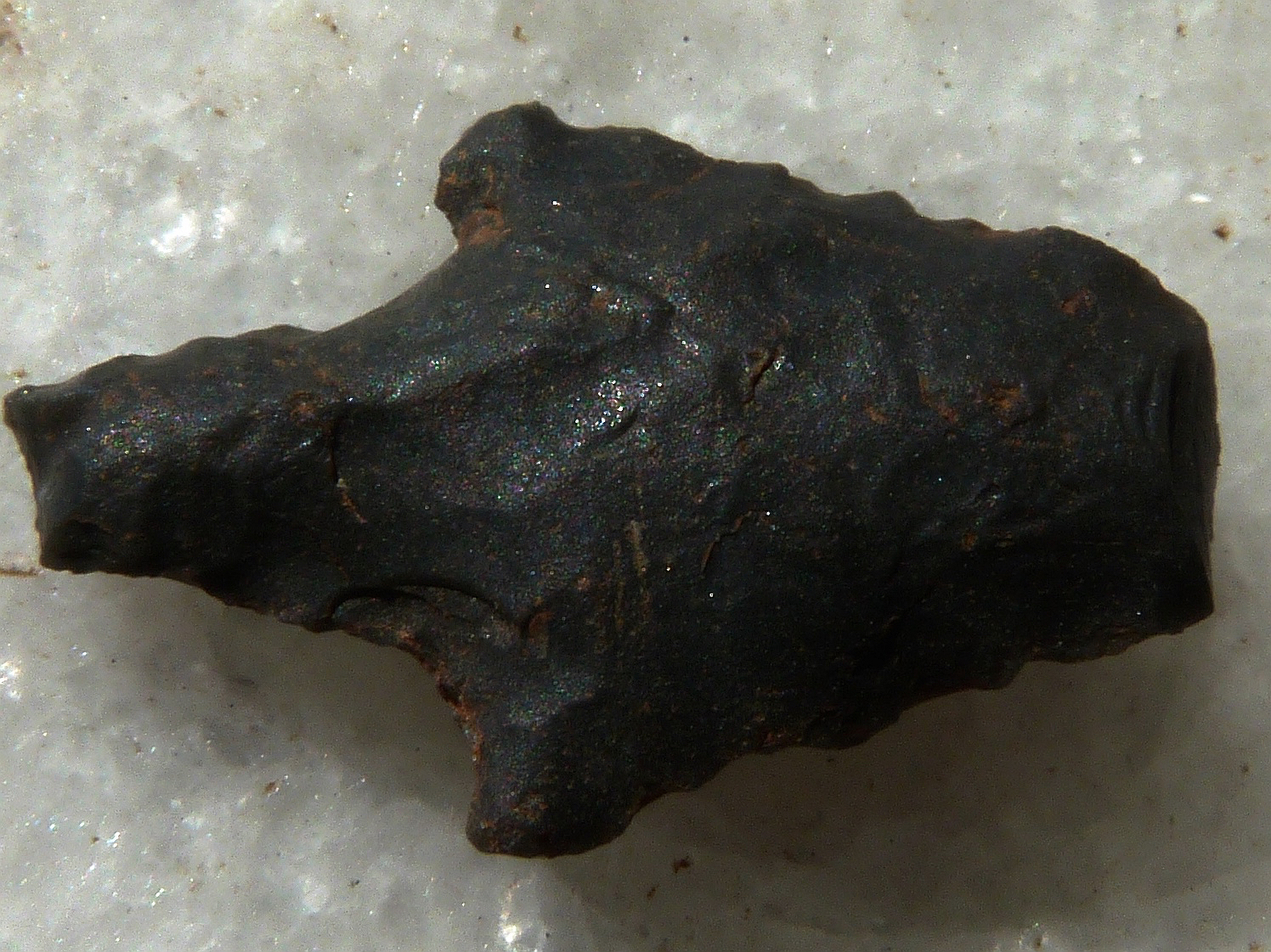
Fragment of a small arrowhead, probably from the Neolithic
Obsidian and Flint
Obsidian is a volcanic stone. It is formed by rapid cooling from lava that is rich in silicates, but contains only little water. In Europe Obsidian occurs except for the Greek islands Milos and Gyali in some places in Italy, Iceland, Switzerland and Hungary; also it occurs in Asia Minor.
Flintstone also consists of silicates. It is found, for example, at the Baltic Sea and in southern England in limestone and chalk areas. Flint occurs in nodules that form in limestone layers, possibly already during sedimentation due to the deposition of diatoms, or due to subsequent penetration of silica-rich liquids into the rock. Here the silicate is very finely crystalline. Flint is black or dark grey and weathers on the surface to form a white layer. It breaks in the same way as obsidian with conchoidal fracture. It occurs in many places in Europe, sometimes in large amounts; in some areas it was mined in underground mines during the Stone age.
Flint and obsidian can be used to make various tools such as scrapers, blades, arrowheads, etc. The technique of processing developed considerably over the course of the Stone age. First the blades were split off by blows, later by pressing with a piece of antlers or something similar. Although flint and obsidian blades are difficult to make and fragile and can hardly exceed a certain size, they are much sharper than all metal knives and do loose their sharpness. Today, small obsidian blades are still used in cosmetic surgery because the scars heal better than those from metal knives. Besides tools, obsidian was also used for vessels (Hittites), mirrors (Rome), figures representing gods (Mexico) and even swords (Aztecs).
Other crafts
In addition to obsidian, the Stone age people also used other stones to make tools. Because of its fragility, the obsidian was not suitable for axes or hatchets. These were often made of basalt (which, like the obsidian, does not occur on Naxos itself), chert or other hard rocks, which, unlike the obsidian, can be whetted. Also the first idols were made out of stone.
In addition, the Stone age people discovered and developed a many other handicraft techniques, especially in the last phase of the Neolithic. As one of the first handicrafts the weaving of baskets was developed, of which however naturally hardly any traces have remained. Also pottery was invented and greatly refined over time. It is interesting to note that many pottery items of the Stone age carry an ornamentation with carvings reminiscent of woven baskets. That suggests that pottery first emerged because the Stone age people learned to seal their baskets with clay (and yes, then there was the clumsy housewife who placed her basket too close to the fire, so that the wickerwork burned away and – what was that? the first clay pot!)

Stone age clay vessels from the Cave of Mount Zeus (Archeological Museum in the Chóra)
The Neolithic people processed leather and wool, and they used the wool for spinning and weaving. They made simple tools and utensils out of bone and wood. Finally, towards the end of the Neolithic period, metalworking was discovered, which opened up completely new possibilities concerning the manufacture of tools. With the development of needles, awls, nails, axes, hooks and finally also saws, other crafts such as manufacture of clothes, carpentry, shipbuilding and agriculture also experienced a rapid evolution. However, during the Stone age and the Bronze age metal objects were still rare and certainly also very valuable. Perhaps this is a reason why so few metal objects from this early period have survived: Because of the scarcity of the material, the objects that were no longer used were probably mostly melted down and made into something else.
The Neolithic age on Naxos
On Naxos layers dated to the Neolithic period were found in excavations in Grótta in the Chóra (close to the land bridge to the Palátia Island with the Temple of Apollo). The most important Neolithic finds on the island were made in the excavations in the Cave on Mount Zeus, which was used by the inhabitants of the island from the Neolithic age to the Classical period. Numerous animal bones, seeds and artefacts have been found which allow us to draw conclusions about the life of the Neolithic settlers.

in the cave of Zeus
The neolithic people already cultivated barley, wheat, peas and lentils and gathered wild fruits such as figs, plums and grapes. They already kept the same farm animals as today (goats, sheep, pigs and cows, only the chicken was missing; this only came to Greece at the beginning of the Classical period). Hunting was also practised: On Saliágos bones of fallow deer and red deer were found.
The Stone age users of the Cave on Mount Zeus made carefully crafted tools such as knives, scrapers and spearheads from obsidian. They wove fine fabrics of wool, processed skins and produced high quality pottery. They used the first metal tools such as spatulas, awls, needles, knives and axes (made of bronze containing arsenic). In the cave a finely worked marble bowl was also found. Noteworthy are small female stone figures from Saliágos and Sangrí on Naxos, which can be regarded as direct precursors of the famous Cycladic idols of the Bronze age.
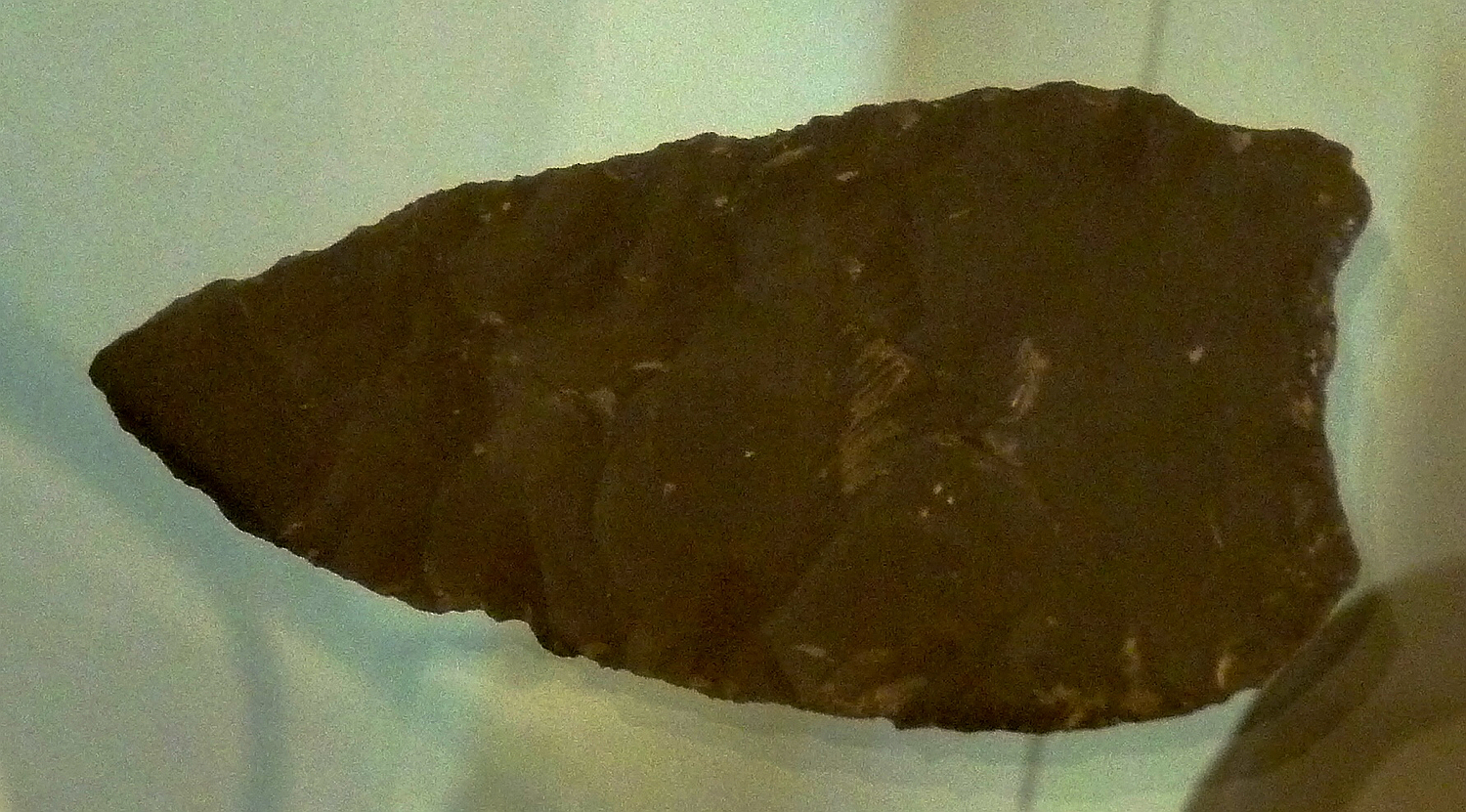
obsidian spearhead from the Cave on Mount Zeus (Archeological Museum Chóra)

Stone age idol found near Sangrí (Museum Chóra)
So far only in Grótta remains of a stone-age settlement have been discovered. Isolated finds of tools or other artefacts are also known from other areas of the island; for example, a serpentine axe was found near Moutsoúna. The rich finds from the Cave on Mount Zeus prove the existence of a permanent, albeit thin, settlement, of which only few remains have survived (or maybe they have not yet been discovered). The same is true of Milos, where obsidian was definitely mined on a large scale around 7,000 B.C., but only very few traces of Stone age settlements have been found.
In the alluvial plains and river valleys on the east coast of Naxos, obsidian can be found almost everywhere, mostly splinters, as they occur during the processing of the material and the manufacture of tools, sometimes also fragments of blades or a scattered arrowhead. While arrowheads, scrapers and other round or pointed obsidian tools on the Cyclades are generally regarded as Stone age, the narrow, sometimes very long blades with parallel edges are dated to the Early Bronze age. Occasionally also fragments of polished axes (sometimes made from other types of stone: serpentine, basalt, siliceous slate, chert, etc.) are found, which can also be dated to the Stone age. It is noticeable that usually no potsherds accompany the obsidian splinters: Apparently the obsidian fragments originate from a time in which no or hardly any pottery was used. This is also known from other places in southern Greece where pottery is still missing in the earlier Stone age layers.
Relations with neighbouring regions
The pottery found in the Cave on Mount Zeus shows similarities in form and decoration with vessels from the East Aegean islands and from the Troas in northwest Asia Minor. Also common treats with pottery from the Kephala culture that existed at the same time in Kea and Attica as well as with that from other neighbouring areas in the west can be detected.
A small piece of gold plate found in the Cave on Mount Zeus is of particular significance as it proves the existence of trade with more distant regions and represents the oldest gold object of the Cyclades. It is so similar to pieces from the famous Stone age gold treasure of Varna in Bulgaria that there can be no doubt that it came from there. Conversely, a marble vase and jewellery made of shells that probably originate from the Aegean islands were found in the cemetery in Varna – evidence of trade connections between the two regions.
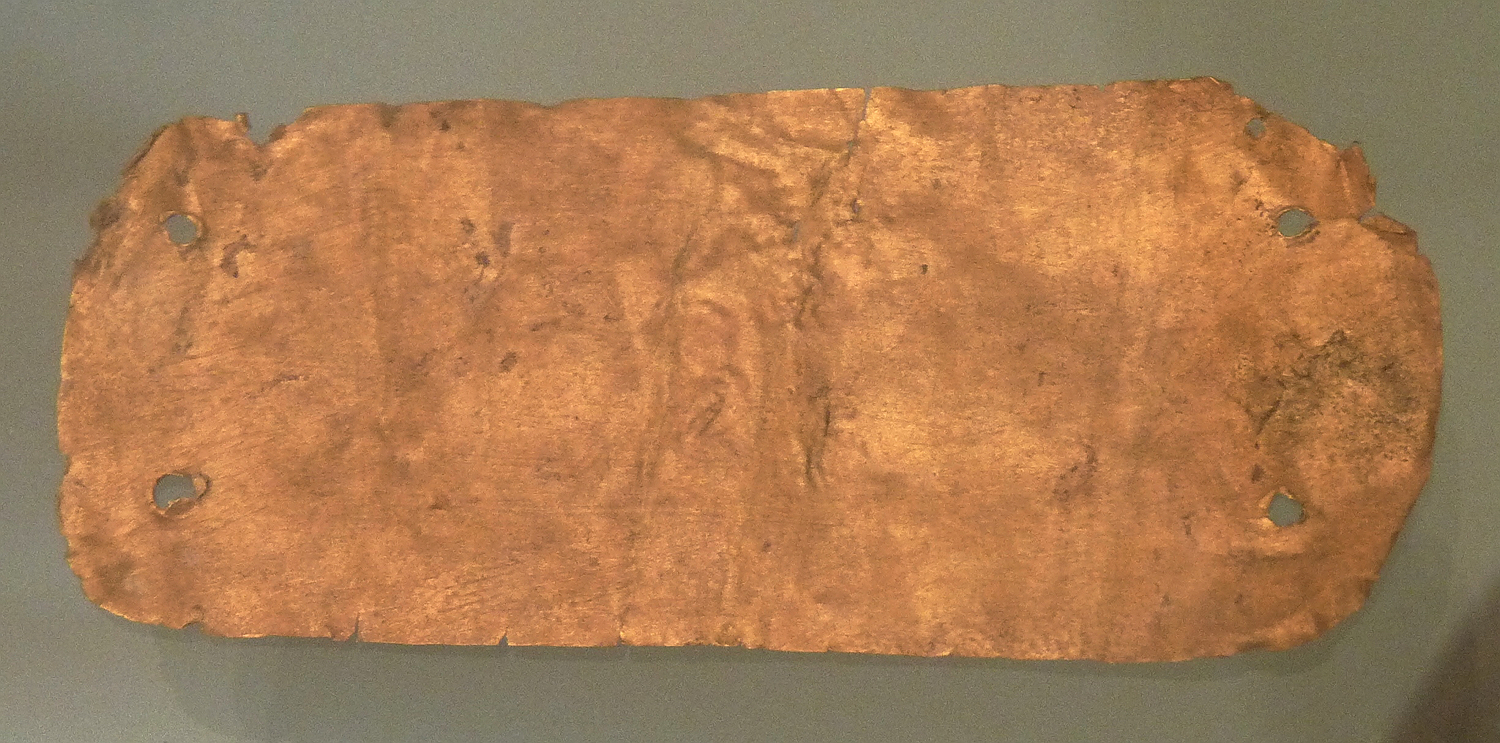
the small gold plate found in the Cave on Mount Zeus (Archeological Museum in the Chóra)
The transition to the Bronze age
As far as the known finds show, the transition from the Neolithic to the Bronze age culture took place gradually. Almost all of the characteristic artefacts and cultural peculiarities of the Early Bronze age show direct precursors in the Neolithic age. Of course trade and travel over the centuries have brought numerous external influences to the Cyclades, which were reflected in customs and craft techniques, but no sudden discontinuity in culture and settlement is detectable: The unique and characteristic Cycladic Bronze age culture developed directly out of the Neolithic culture of the same islands, and the Bronze age inhabitants of the Cyclades were probably the same people as in the Stone age.
see also:
used literature: Κωνσταντίνος Ζάχος, Αρχαιολογικές έρευνες στο σπήλαιο του Ζα, Η Νάξος δια μέσου των Αιώνων, Πρακτικά του Α Πανελλήνιου Συνεδρίου, Επιμέλεια: Ιωάννης Κ. Προμπονάς, Στέφανος Ε. Ψαρράς, Αθήνα 1994